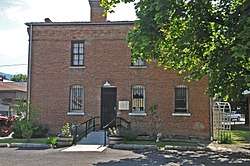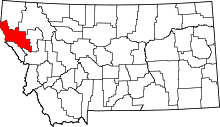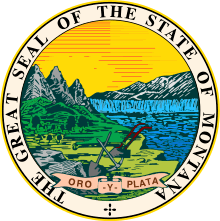Sanders County, Montana
Coordinates: 47°40′N 115°08′W / 47.66°N 115.13°W
| Sanders County, Montana | |
|---|---|
 | |
 Location in the U.S. state of Montana | |
 Montana's location in the U.S. | |
| Founded | 1905 |
| Seat | Thompson Falls |
| Largest city | Thompson Falls |
| Area | |
| • Total | 2,790 sq mi (7,226 km2) |
| • Land | 2,761 sq mi (7,151 km2) |
| • Water | 29 sq mi (75 km2), 1.1% |
| Population (est.) | |
| • (2017) | 11,711[1] |
| • Density | 4.2/sq mi (1.6/km2) |
| Congressional district | At-large |
| Time zone | Mountain: UTC−7/−6 |
| Website |
www |
Sanders County is a county located in the U.S. state of Montana. As of the 2010 census, the population was 11,413.[2] Its county seat is Thompson Falls.[3] The county was founded in 1905.[4]
Geography
According to the U.S. Census Bureau, the county has a total area of 2,790 square miles (7,200 km2), of which 2,761 square miles (7,150 km2) is land and 29 square miles (75 km2) (1.1%) is water.[6]
It is located on the west edge of the state of Montana, with a variety of mountains – it is part of the Coeur d'Alene Mountains in the Bitterroot Range. The Clark Fork River runs through the middle of the county; Southeast to Northwest flow orientation with the Bitterroot Mountains on the Southwestern side and the Cabinet Mountains to the Northeast. Like many river systems of Western Montana, the Clark Fork is noted for broad, open plains along its banks.
It is partially arid, with the west-facing mountain slopes capturing the most rain: ranging from nearly 40 inches a year in Heron (similar to Seattle's annual precipitation) on the Western end of the county to less than 12 inches per year in Dixon on the East end.
During the last ice age, this was the area that dammed the glacial Lake Missoula. When the ice dam broke, the resulting floods created the Scablands in eastern Washington.[7]
Adjacent counties
- Lincoln County, Montana – north
- Flathead County, Montana – northeast
- Lake County, Montana – east
- Missoula County, Montana – southeast
- Mineral County, Montana – south
- Shoshone County, Idaho – west/Pacific Time Border
- Bonner County, Idaho – northwest/Pacific Time Border
National protected areas
- Kaniksu National Forest (part)
- Kootenai National Forest (part)
- Lolo National Forest (part)
- National Bison Range (part)
Fauna
A variety of birds and other wildlife are found in Sanders County. The Tufted duck has been observed along the Bull River. An amphibian, the Rough-skinned Newt, has a disjunctive population at Thompson Falls which is un-contiguous with the remainder of the Western United States population of this species.[8]
Like most of Western Montana, Sanders County is a "destination hunting locale" with trophy specimens of White-tailed Deer (Odocoileus virginianus), Mule Deer (Odocoileus hemionus), Rocky Mountain Elk (Cervus canadensis nelsoni), Shiras Moose (Alces alces Shirasi), Mountain Goat(Oreamnos americanus), and Bighorn Sheep (Ovis canadensis Canadensis) rounding out huntable ungulate species and Black Bear, Cougar and Wolves comprising the huntable carnivores. Perhaps most notable of the species is the massive-horned Rocky Mountain Bighorns taken regularly from the flocks in the county. Three of the Top 10 heads in the Record Books were taken in Sanders County -Vying with British Columbia as the top producer of great heads. Astounding to realize, is that the combination of great habitat, genetics and age structure of the flocks has some rams as young as 7 years of age qualifying for the record book and some of the massive heads have basal circumferences surpassing 18 INCHES (Most "huge" horns around the world are found on 10-13-year-old rams with circumferences of 14–16 inches)
Grizzly Bear, the Montana State Animal, are also found in the county, but as an endangered species, they are un-huntable at this time. Montana had the last huntable population of Grizzlies in the lower 48, allowing 10 bears a year (natural deaths, poaching and other causes of death were included in that total to decide when season closed) as late as the 1990s. Only Alaska allows hunting for Grizzlies now.
Western Meadowlark, the state bird are found sparsely in the meadow areas of Sanders County along with Redwing Blackbird and Rocky Mountain Bluebirds... some of the favorites at local birdfeeders.
The westslope cutthroat trout (Onchorynchus clarki lewisi) is native to the drainages of Sanders County. The threatened native bull trout relies on westslopes as a major prey species in its piscivorous diet. Catch and release fishing is required to maintain fishable populations of the two natives, which now compete with introduced rainbow trout, and warm-water species, such as largemouth bass, yellow perch, Northern Pike, and walleyes that have been introduced and thrive in the modified habitat of the Clark Fork River's reservoirs.
Flora
Sanders County is part of the "mountainous" western third of the state. It lies entirely on the western slopes of the Rocky Mountains with a mixed coniferous forest dominating the plant community. Douglas fir/Ponderosa pine (Montana state tree) climax plant community dominate much of the county, but there are numerous other conifers found there as well in pockets of micro-climates suited to their needs. These include Western red cedar, Western Hemlock, Mountain Hemlock, White Spruce, Subalpine Fir, Grand Fir, Western White Pine, Lodgepole Pine and one of the most spectacular, Western larch, one of a handful of deciduous conifers that turn gold in the autumn before dropping all their needles.
Numerous broadleaf species proliferate in Sanders County as well. Rocky Mountain Maple, Red Alder, Paperbark Birch, Chokecherry, and numerous cottonwood and poplars as well light up the creek bottoms in autumn with their annual display of fall color.
Arguably the most popular broad-leaf shrub in Sanders County is the Rocky Mountain huckleberry (Vaccinium membranaceum). Trout Creek, Montana 59874 is considered the "Huckleberry Capital of Montana" and holds an annual celebration of the fruit called the "Huckleberry Festival" in August when the fruits ripen at high elevations. Though related to the common blueberry (Vaccinium corymbosum) very few have managed to grow Rocky Mountain huckleberry in domestic cultivation. It is commonly found in plant communities with beargrass (Xerophyllum tenax), a perennial found in burned or logged-over areas of the mountain ranges in the county.
The bitterroot (Lewisia rediviva) is the state flower and found in limited quantities in Sanders County, though the prairie hills in Missoula County drew Native tribes from surrounding areas to dig the roots for food annually.
Demographics
| Historical population | |||
|---|---|---|---|
| Census | Pop. | %± | |
| 1910 | 3,713 | — | |
| 1920 | 4,903 | 32.0% | |
| 1930 | 5,692 | 16.1% | |
| 1940 | 6,926 | 21.7% | |
| 1950 | 6,983 | 0.8% | |
| 1960 | 6,880 | −1.5% | |
| 1970 | 7,093 | 3.1% | |
| 1980 | 8,675 | 22.3% | |
| 1990 | 8,669 | −0.1% | |
| 2000 | 10,227 | 18.0% | |
| 2010 | 11,413 | 11.6% | |
| Est. 2017 | 11,711 | [9] | 2.6% |
| U.S. Decennial Census[10] 1790–1960[11] 1900–1990[12] 1990–2000[13] 2010–2015[2] | |||
2000 census
As of the census[14] of 2000, there were 10,227 people, 4,273 households, and 2,897 families residing in the county. The population density was four people per square mile (1/km²). There were 5,271 housing units at an average density of two per square mile (1/km²). The racial makeup of the county was 91.91% White, 0.13% Black or African American, 4.74% Native American, 0.30% Asian, 0.01% Pacific Islander, 0.26% from other races, and 2.64% from two or more races. 1.55% of the population were Hispanic or Latino of any race. 20.1% were of German, 12.1% English, 11.0% Irish, 7.9% American and 6.5% Norwegian ancestry. 96.9% spoke English, 1.4% German and 1.2% Spanish as their first language.
There were 4,273 households out of which 26.20% had children under the age of 18 living with them, 57.30% were married couples living together, 7.10% had a female householder with no husband present, and 32.20% were non-families. 28.00% of all households were made up of individuals and 11.60% had someone living alone who was 65 years of age or older. The average household size was 2.35 and the average family size was 2.86.
In the county, the population was spread out with 23.80% under the age of 18, 5.50% from 18 to 24, 22.10% from 25 to 44, 31.80% from 45 to 64, and 16.90% who were 65 years of age or older. The median age was 44 years. For every 100 females there were 102.10 males. For every 100 females age 18 and over, there were 100.50 males.
The median income for a household in the county was $26,852, and the median income for a family was $31,340. Males had a median income of $28,340 versus $17,630 for females. The per capita income for the county was $14,593. About 13.30% of families and 17.20% of the population were below the poverty line, including 23.30% of those under age 18 and 9.20% of those age 65 or over.
2010 census
As of the 2010 United States Census, there were 11,413 people, 5,121 households, and 3,204 families residing in the county.[15] The population density was 4.1 inhabitants per square mile (1.6/km2). There were 6,678 housing units at an average density of 2.4 per square mile (0.93/km2).[16] The racial makeup of the county was 91.6% white, 4.4% American Indian, 0.3% Asian, 0.1% black or African American, 0.4% from other races, and 3.1% from two or more races. Those of Hispanic or Latino origin made up 2.0% of the population.[15] In terms of ancestry, 32.2% were German, 16.4% were English, 16.1% were Irish, 9.1% were Norwegian, 6.3% were Swedish, and 3.3% were American.[17]
Of the 5,121 households, 22.4% had children under the age of 18 living with them, 52.8% were married couples living together, 6.2% had a female householder with no husband present, 37.4% were non-families, and 32.8% of all households were made up of individuals. The average household size was 2.19 and the average family size was 2.75. The median age was 49.8 years.[15]
The median income for a household in the county was $30,622 and the median income for a family was $37,514. Males had a median income of $32,857 versus $22,274 for females. The per capita income for the county was $18,472. About 16.6% of families and 21.3% of the population were below the poverty line, including 33.9% of those under age 18 and 11.1% of those age 65 or over.[18]
Transportation
The Hot Springs Airport is a county-owned public-use airport located two nautical miles (4 km) east of the central business district of Hot Springs.[19]
Politics
Bill Clinton carried this county in 1992; he lost this county by 10% in 1996 to Republican Bob Dole. Clinton is the only Democratic candidate to win this county in the past 54 years. Republican Donald Trump won 72% of the vote here in 2016, the highest margin by any Presidential candidate ever in Sanders County.
| Year | Republican | Democratic | Third parties |
|---|---|---|---|
| 2016 | 72.0% 4,286 | 20.5% 1,218 | 7.5% 449 |
| 2012 | 67.5% 3,980 | 29.2% 1,720 | 3.4% 201 |
| 2008 | 60.7% 3,563 | 33.6% 1,970 | 5.7% 335 |
| 2004 | 67.2% 3,461 | 29.2% 1,502 | 3.7% 190 |
| 2000 | 66.6% 3,144 | 24.7% 1,165 | 8.7% 412 |
| 1996 | 43.8% 2,043 | 33.8% 1,573 | 22.4% 1,045 |
| 1992 | 30.2% 1,361 | 37.5% 1,689 | 32.3% 1,456 |
| 1988 | 51.2% 2,152 | 46.6% 1,959 | 2.1% 89 |
| 1984 | 58.7% 2,467 | 39.3% 1,654 | 2.0% 83 |
| 1980 | 54.9% 2,194 | 34.9% 1,395 | 10.3% 410 |
| 1976 | 48.6% 1,738 | 48.2% 1,725 | 3.2% 113 |
| 1972 | 54.7% 1,779 | 36.8% 1,197 | 8.5% 275 |
| 1968 | 48.7% 1,459 | 41.5% 1,242 | 9.9% 295 |
| 1964 | 38.6% 1,163 | 60.9% 1,836 | 0.5% 14 |
| 1960 | 50.2% 1,497 | 49.2% 1,469 | 0.6% 18 |
| 1956 | 52.1% 1,649 | 48.0% 1,519 | 0.0% 0 |
| 1952 | 56.0% 1,724 | 42.6% 1,311 | 1.4% 43 |
| 1948 | 43.0% 1,191 | 51.5% 1,425 | 5.5% 151 |
| 1944 | 47.0% 1,070 | 52.0% 1,184 | 1.1% 24 |
| 1940 | 38.9% 1,088 | 58.5% 1,634 | 2.6% 72 |
| 1936 | 26.3% 718 | 65.4% 1,788 | 8.4% 229 |
| 1932 | 29.2% 760 | 60.6% 1,577 | 10.2% 264 |
| 1928 | 53.7% 1,142 | 41.0% 873 | 5.3% 113 |
| 1924 | 28.7% 588 | 9.2% 188 | 62.2% 1,276 |
| 1920 | 51.5% 1,035 | 36.9% 741 | 11.6% 234 |
| 1916 | 37.3% 793 | 55.4% 1,178 | 7.3% 154 |
| 1912 | 21.3% 257 | 34.3% 414 | 44.4% 536[21] |
| 1908 | 55.0% 473 | 37.8% 325 | 7.2% 62 |
Communities
Cities
- Thompson Falls (county seat)
- Plains
Towns
Census-designated places
See also
References
- ↑ https://factfinder.census.gov/faces/nav/jsf/pages/community_facts.xhtml?src=bkmk
- 1 2 "State & County QuickFacts". United States Census Bureau. Retrieved September 16, 2013.
- ↑ "Find a County". National Association of Counties. Retrieved 2011-06-07.
- ↑ Montana Place Names from Alzada to Zortman. Helena, MT: Montana Historical Society Press. 2009. p. 236.
- ↑ "Sanders County Fair". Sanders County Fair Organization. Retrieved 6 June 2013.
- ↑ "2010 Census Gazetteer Files". United States Census Bureau. August 22, 2012. Archived from the original on December 5, 2014. Retrieved November 30, 2014.
- ↑ "Glacial Lake Missoula". Glacial Lake Missoula. Retrieved 6 June 2013.
- ↑ C. Michael Hogan (2008) Rough-skinned Newt (Taricha granulosa), Globaltwitcher, ed. N. Stromberg "Archived copy". Archived from the original on 2009-05-27. Retrieved 2009-04-06.
- ↑ "Population and Housing Unit Estimates". Retrieved June 9, 2017.
- ↑ "U.S. Decennial Census". United States Census Bureau. Retrieved November 30, 2014.
- ↑ "Historical Census Browser". University of Virginia Library. Retrieved November 30, 2014.
- ↑ "Population of Counties by Decennial Census: 1900 to 1990". United States Census Bureau. Retrieved November 30, 2014.
- ↑ "Census 2000 PHC-T-4. Ranking Tables for Counties: 1990 and 2000" (PDF). United States Census Bureau. Retrieved November 30, 2014.
- ↑ "American FactFinder". United States Census Bureau. Retrieved 2008-01-31.
- 1 2 3 "DP-1 Profile of General Population and Housing Characteristics: 2010 Demographic Profile Data". United States Census Bureau. Retrieved 2016-01-10.
- ↑ "Population, Housing Units, Area, and Density: 2010 – County". United States Census Bureau. Retrieved 2016-01-10.
- ↑ "DP02 SELECTED SOCIAL CHARACTERISTICS IN THE UNITED STATES – 2006–2010 American Community Survey 5-Year Estimates". United States Census Bureau. Retrieved 2016-01-10.
- ↑ "DP03 SELECTED ECONOMIC CHARACTERISTICS – 2006–2010 American Community Survey 5-Year Estimates". United States Census Bureau. Retrieved 2016-01-10.
- ↑ FAA Airport Master Record for S09 (Form 5010 PDF). Federal Aviation Administration. Effective 25 August 2011.
- ↑ Leip, David. "Dave Leip's Atlas of U.S. Presidential Elections". uselectionatlas.org. Retrieved 2018-04-03.
- ↑ The leading "other" candidate, Progressive Theodore Roosevelt, received 375 votes, while Socialist candidate Eugene Debs received 161 votes.
